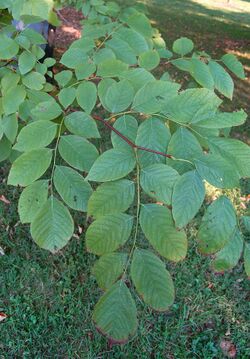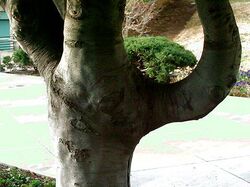Biology:Cladrastis kentukea: Difference between revisions
(update) |
(url) |
||
| Line 1: | Line 1: | ||
{{Short description|Species of legume}} | {{Short description|Species of legume}} | ||
{{For|other plants with a similar common name|Yellowwood (disambiguation){{!}}Yellowwood}} | |||
{{speciesbox | {{speciesbox | ||
|image = கெண்டகி மஞ்ச்சள் மரப்பூச்சரம் Yellowwood flower.jpg | |image = கெண்டகி மஞ்ச்சள் மரப்பூச்சரம் Yellowwood flower.jpg | ||
| Line 15: | Line 16: | ||
|synonyms = | |synonyms = | ||
{{Plainlist | style = margin-left: 1em; text-indent: -1em; | | {{Plainlist | style = margin-left: 1em; text-indent: -1em; | | ||
*''Cladrastis albiflora'' <small>Raf.</small> | * ''Cladrastis albiflora'' <small>Raf.</small> | ||
*''Cladrastis fragrans'' <small>Raf.</small> | * ''Cladrastis fragrans'' <small>Raf.</small> | ||
*''Cladrastis kentuckensis'' <small>(Dum.Cours.) Jacks.</small> | * ''Cladrastis kentuckensis'' <small>(Dum.Cours.) Jacks.</small> | ||
*''Cladrastis kentuckensis'' <small>Raf.</small> | * ''Cladrastis kentuckensis'' <small>Raf.</small> | ||
*''Cladrastis kentuckensis'' <small>Raf. ex B.D. Jacks.</small> | * ''Cladrastis kentuckensis'' <small>Raf. ex B.D. Jacks.</small> | ||
*''Cladrastis lutea'' <small>(Michx.) K.Koch</small> | * ''Cladrastis lutea'' <small>(Michx.) K.Koch</small> | ||
*''Cladrastis lutea'' <small>Raf.</small> | * ''Cladrastis lutea'' <small>Raf.</small> | ||
*''Cladrastis tinctoria'' <small>Raf.</small> | * ''Cladrastis tinctoria'' <small>Raf.</small> | ||
*''Sophora kentukea'' <small>Dum.Cours.</small> | * ''Sophora kentukea'' <small>Dum.Cours.</small> | ||
*''Virgilia alba'' <small>Raf.</small> | * ''Virgilia alba'' <small>Raf.</small> | ||
*''Virgilia kentuckensis'' <small>Raf.</small> | * ''Virgilia kentuckensis'' <small>Raf.</small> | ||
*''Virgilia lutea'' <small>Michx.</small> | * ''Virgilia lutea'' <small>Michx.</small> | ||
}} | }} | ||
|synonyms_ref = <ref>{{ | |synonyms_ref = <ref>{{Cite web |title=The Plant List: A Working List of All Plant Species |url=http://www.theplantlist.org/tpl1.1/record/ild-10746 |access-date=27 March 2015}}</ref> | ||
}} | }} | ||
'''''Cladrastis kentukea''''', the '''Kentucky yellowwood''' or '''American yellowwood''' (syn. ''C. lutea'', ''C. tinctoria''), is a species of ''[[Biology:Cladrastis|Cladrastis]]'' native to the Southeastern United States, with a restricted range from western North Carolina west to eastern Oklahoma, and from southern Missouri and | '''''Cladrastis kentukea''''', the '''Kentucky yellowwood''' or '''American yellowwood''' (syn. ''C. lutea'', ''C. tinctoria''), is a species of ''[[Biology:Cladrastis|Cladrastis]]'' native to the Southeastern United States, with a restricted range from western North Carolina west to eastern Oklahoma, and from southern Missouri and Indiana south to central Alabama. The tree is sometimes also called '''Virgilia'''.<ref name="Keeler">{{Cite book |last=Keeler |first=Harriet L. |url=https://archive.org/details/ournativetreesa02keelgoog |title=Our Native Trees and How to Identify Them |date=1900 |publisher=Charles ScribNer's Sons |location=New York |pages=[https://archive.org/details/ournativetreesa02keelgoog/page/n145 116]–118}}</ref> | ||
==Description== | ==Description== | ||
[[File:Cladrastis kentukea Yellowwood Branch 2000px.jpg|thumb|left|Leaves]] | [[File:Cladrastis kentukea Yellowwood Branch 2000px.jpg|thumb|left|Leaves]] | ||
''Cladrastis kentukea'' is a small to medium-sized [[Biology:Deciduous|deciduous]] [[Earth:Tree|tree]] typically growing {{convert|10|-|15|m|ft}} tall, exceptionally to {{convert|27|m|ft}} tall, with a broad, rounded crown and smooth gray [[Biology:Bark (botany)|bark]]. The [[Biology:Leaf|leaves]] are compound pinnate, 20–30 cm long, with 5-11 (mostly 7-9) alternately arranged leaflets; each leaflet broad ovate with an acute apex; 6–13 cm long and 3–7 cm broad, with an entire margin and a thinly to densely hairy underside. In the fall, the leaves turn a mix of yellow, gold, and orange. | ''Cladrastis kentukea'' is a small to medium-sized [[Biology:Deciduous|deciduous]] [[Earth:Tree|tree]] typically growing {{convert|10|-|15|m|ft}} tall, exceptionally to {{convert|27|m|ft}} tall, with a broad, rounded crown and smooth gray [[Biology:Bark (botany)|bark]]. The [[Biology:Leaf|leaves]] are compound pinnate, 20–30 cm long, with 5-11 (mostly 7-9) alternately arranged leaflets; each leaflet broad ovate with an acute apex; 6–13 cm long and 3–7 cm broad, with an entire margin and a thinly to densely hairy underside. In the fall, the leaves turn a mix of yellow, gold, and orange.{{cn|date=September 2024}} | ||
The [[Biology:Flower|flower]]s are fragrant, white, produced in ''[[Biology:Wisteria|Wisteria]]''-like [[Biology:Raceme|raceme]]s 15–30 cm long. Flowering is in early summer (June in its native region), and is variable from year to year, with heavy flowering every second or third year. The [[Biology:Fruit|fruit]] is a [[Biology:Legume|pod]] 5–8 cm long, containing 2-6 seeds.{{cn|date=September 2024}} | |||
* Bark: Smooth gray, or light brown. Branchlets at first downy, but soon become smooth, light yellowish green; later red brown, finally dark brown. | * Bark: Smooth gray, or light brown. Branchlets at first downy, but soon become smooth, light yellowish green; later red brown, finally dark brown. | ||
* Wood: Yellow to pale brown; heavy, hard, close-grained and strong. Sp. gr., 0.6278; weight of cu. ft., 39.12 lbs. | * Wood: Yellow to pale brown; heavy, hard, close-grained and strong. Sp. gr., 0.6278; weight of cu. ft., 39.12 lbs. | ||
| Line 48: | Line 48: | ||
* Stamens: Ten, free; filaments thread-like. | * Stamens: Ten, free; filaments thread-like. | ||
* Pistil: Ovary superior, linear, bright red, hairy, bearing a long incurved style. | * Pistil: Ovary superior, linear, bright red, hairy, bearing a long incurved style. | ||
* Fruit: Legume, smooth, linear-compressed, tipped with the remnants of the styles. Seeds four to six, dark brown.<ref name=Keeler /> | * Fruit: Legume, smooth, linear-compressed, tipped with the remnants of the styles. Seeds four to six, dark brown.<ref name="Keeler" /> | ||
==Distribution== | ==Distribution== | ||
One of the rarest trees of eastern [[Earth:North America|North America]].<ref>{{Cite web |last=Chen |first=Kevin |date=December 19, 2017 |title=Yellowwood (Cladrastis kentukea) {{!}} University of Minnesota Urban Forestry and Research: The UFOR Nursery & Lab |url=https://trees.umn.edu/yellowwood-cladrastis-kentukea |access-date=2023-05-09 |website=trees.umn.edu}}</ref> Found principally on the limestone cliffs of Kentucky, Tennessee and North Carolina, but it is hardy at the north to zone 4. | One of the rarest trees of eastern [[Earth:North America|North America]].<ref>{{Cite web |last=Chen |first=Kevin |date=December 19, 2017 |title=Yellowwood (Cladrastis kentukea) {{!}} University of Minnesota Urban Forestry and Research: The UFOR Nursery & Lab |url=https://trees.umn.edu/yellowwood-cladrastis-kentukea |access-date=2023-05-09 |website=trees.umn.edu}}</ref> Found principally on the limestone cliffs of Kentucky, Tennessee and North Carolina, but it is hardy at the north to zone 4.{{cn|date=September 2024}} | ||
The largest specimen known is at Spring Grove Cemetery in Cincinnati, Ohio, 22 m tall and 2.2 m trunk diameter; the tallest known is a slender tree 27 m tall but only 0.55 m trunk diameter, at Plott Cove Research Natural Area, Georgia (Spongberg & Ma 1997; Eastern Native Trees Society). | The largest specimen known is at Spring Grove Cemetery in Cincinnati, Ohio, 22 m tall and 2.2 m trunk diameter; the tallest known is a slender tree 27 m tall but only 0.55 m trunk diameter, at Plott Cove Research Natural Area, Georgia (Spongberg & Ma 1997; Eastern Native Trees Society). | ||
Plants from Alabama have the leaves more densely hairy underneath than those from further north, and are distinguished as ''Cladrastis kentukea'' f. ''tomentosa'' (Steyermark) Spongberg. | Plants from Alabama have the leaves more densely hairy underneath than those from further north, and are distinguished as ''Cladrastis kentukea'' f. ''tomentosa'' (Steyermark) Spongberg.{{cn|date=September 2024}} | ||
==Cultivation== | ==Cultivation== | ||
''Cladrastis kentukea'' is widely grown as an ornamental tree for its attractive flowers, and is locally [[Biology:Naturalisation|naturalized]] in many areas of the eastern United States outside of its restricted [[Earth:Native plant|native]] range.<ref name=Keeler /> It thrives in full sunlight and in well-drained soil, tolerates high pH soils as well as acid situations. The Yellowwood can withstand urban settings and is attractive to birds. A number of [[Biology:Cultivar|cultivar]]s have been selected, including 'Perkin's Pink' (syn. 'Rosea', an invalid name) with pink flowers. | ''Cladrastis kentukea'' is widely grown as an ornamental tree for its attractive flowers, and is locally [[Biology:Naturalisation|naturalized]] in many areas of the eastern United States outside of its restricted [[Earth:Native plant|native]] range.<ref name="Keeler" /> It thrives in full sunlight and in well-drained soil, tolerates high pH soils as well as acid situations. The Yellowwood can withstand urban settings and is attractive to birds. A number of [[Biology:Cultivar|cultivar]]s have been selected, including 'Perkin's Pink' (syn. 'Rosea', an invalid name) with pink flowers.{{cn|date=September 2024}} | ||
Kentucky yellowwood is recommended as one of the best medium-sized trees for cultivation as an ornamental plant in gardens. The only quality that is mentioned is a tendency of the trunk to divide very near the ground, as a multi-trunked tree.<ref name=Keeler /> [[File: | Kentucky yellowwood is recommended as one of the best medium-sized trees for cultivation as an ornamental plant in gardens. The only quality that is mentioned is a tendency of the trunk to divide very near the ground, as a multi-trunked tree.<ref name="Keeler" /> [[File:Yellow WoodTree Bark and low branching-Cladrastis kentukea, family Fabaceae.jpg|thumb|right|bark and low branching habit]] | ||
==Uses== | ==Uses== | ||
The name yellowwood derives from its yellow heartwood, used in small amounts for specialist [[Engineering:Furniture|furniture]], gunstocks and decorative [[Engineering:Woodturning|woodturning]]. | The name yellowwood derives from its yellow heartwood, used in small amounts for specialist [[Engineering:Furniture|furniture]], gunstocks and decorative [[Engineering:Woodturning|woodturning]].{{cn|date=September 2024}} | ||
This plant has been marked as a pollinator plant, supporting and attracting bees and butterflies.<ref>{{Cite web|title=Planting Guides|url=https://www.pollinator.org/pollinator.org/assets/generalFiles/OzarkBroadleafrx1FINAL_171017_085901.pdf|access-date=2022-01-29|website=Pollinator.org|language=en-US}}</ref> | This plant has been marked as a pollinator plant, supporting and attracting bees and butterflies.<ref>{{Cite web |title=Planting Guides |url=https://www.pollinator.org/pollinator.org/assets/generalFiles/OzarkBroadleafrx1FINAL_171017_085901.pdf |access-date=2022-01-29 |website=Pollinator.org |language=en-US}}</ref> | ||
==Distinctions== | ==Distinctions== | ||
Yellowwood won a Pennsylvania Horticultural Society Gold Award in 1994.<ref>{{ | Yellowwood won a Pennsylvania Horticultural Society Gold Award in 1994.<ref>{{Cite web |title=Yellowwood Tree Profile |url=https://www.uky.edu/hort/?q=Yellowwood |access-date=11 June 2019 |website=UK Department of Horticulture |publisher=Kentucky Cooperative Extension}}</ref> | ||
The Society of Municipal Arborists selected the yellowwood (''Cladrastis kentukea'' or ''C. lutea'') as its Urban Tree of the Year for 2015. | The Society of Municipal Arborists selected the yellowwood (''Cladrastis kentukea'' or ''C. lutea'') as its Urban Tree of the Year for 2015.{{cn|date=September 2024}} | ||
==References== | ==References== | ||
*Andrews, S. Trees of the Year: Cladrastis and Maakia. ''Int. Dendrol. Soc. Year Book'' 1996: 12–26. | * Andrews, S. Trees of the Year: Cladrastis and Maakia. ''Int. Dendrol. Soc. Year Book'' 1996: 12–26. | ||
*Spongberg, S. A. & Ma, J.-S. (1997). Cladrastis (Leguminosae subfamily Faboideae tribe Sophoreae): a historic and taxonomic overview. ''Int. Dendrol. Soc. Year Book'' 1996: 27–35. | * Spongberg, S. A. & Ma, J.-S. (1997). Cladrastis (Leguminosae subfamily Faboideae tribe Sophoreae): a historic and taxonomic overview. ''Int. Dendrol. Soc. Year Book'' 1996: 27–35. | ||
<references /> | <references /> | ||
==External links== | ==External links== | ||
*[ | * [https://www.pfaf.org/user/Plant.aspx?LatinName=Cladrastis+lutea Plants for a Future: ''Cladrastis lutea''] | ||
{{Taxonbar|from=Q470025}} | {{Taxonbar|from=Q470025}} | ||
Latest revision as of 19:56, 26 June 2025
| Cladrastis kentukea | |
|---|---|
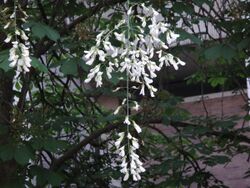
| |
| Kentucky yellowwood flowers | |
| Scientific classification Error creating thumbnail: Unable to save thumbnail to destination
| |
| Kingdom: | Plantae |
| Clade: | Tracheophytes |
| Clade: | Angiosperms |
| Clade: | Eudicots |
| Clade: | Rosids |
| Order: | Fabales |
| Family: | Fabaceae |
| Subfamily: | Faboideae |
| Genus: | Cladrastis |
| Species: | C. kentukea
|
| Binomial name | |
| Cladrastis kentukea (Dum.Cours.) Rudd (1971)
| |
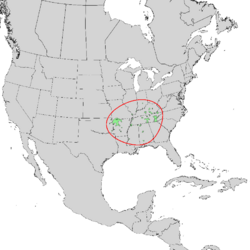
| |
| Natural range of Cladrastis kentukea | |
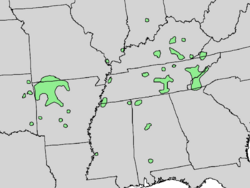
| |
| Close-up of natural range of Cladrastis kentukea | |
| Synonyms[2] | |
| |
Cladrastis kentukea, the Kentucky yellowwood or American yellowwood (syn. C. lutea, C. tinctoria), is a species of Cladrastis native to the Southeastern United States, with a restricted range from western North Carolina west to eastern Oklahoma, and from southern Missouri and Indiana south to central Alabama. The tree is sometimes also called Virgilia.[3]
Description
Cladrastis kentukea is a small to medium-sized deciduous tree typically growing 10–15 metres (33–49 ft) tall, exceptionally to 27 metres (89 ft) tall, with a broad, rounded crown and smooth gray bark. The leaves are compound pinnate, 20–30 cm long, with 5-11 (mostly 7-9) alternately arranged leaflets; each leaflet broad ovate with an acute apex; 6–13 cm long and 3–7 cm broad, with an entire margin and a thinly to densely hairy underside. In the fall, the leaves turn a mix of yellow, gold, and orange.[citation needed]
The flowers are fragrant, white, produced in Wisteria-like racemes 15–30 cm long. Flowering is in early summer (June in its native region), and is variable from year to year, with heavy flowering every second or third year. The fruit is a pod 5–8 cm long, containing 2-6 seeds.[citation needed]
- Bark: Smooth gray, or light brown. Branchlets at first downy, but soon become smooth, light yellowish green; later red brown, finally dark brown.
- Wood: Yellow to pale brown; heavy, hard, close-grained and strong. Sp. gr., 0.6278; weight of cu. ft., 39.12 lbs.
- Winter buds: Four in a group, making a tiny cone and enclosed in the hollow base of the petiole.
- Leaves: Alternate, pinnately compound, eight to twelve inches long, main stem stout, enlarged at base. Leaflets seven to eleven, broadly oval, three to four inches long. Wedge-shaped at base, entire, acute, terminal leaflets rhomboid-ovate. Feather-veined, midrib and primary veins prominent, grooved above, light yellow beneath. They come out the bud pale green, downy; when full grown are dark green above, pale beneath. In autumn they turn a bright clear yellow.
- Flowers: June. Perfect, papilionaceous, white, borne in drooping terminal panicles twelve to fourteen inches long, five to six inches broad, slightly fragrant.
- Calyx: Campanulate, five-lobed, enlarged on the upper side.
- Corolla: Papilionaceous; standard broad, white, marked on the inner surface with a pale yellow blotch; wings oblong; keel petals free.
- Stamens: Ten, free; filaments thread-like.
- Pistil: Ovary superior, linear, bright red, hairy, bearing a long incurved style.
- Fruit: Legume, smooth, linear-compressed, tipped with the remnants of the styles. Seeds four to six, dark brown.[3]
Distribution
One of the rarest trees of eastern North America.[4] Found principally on the limestone cliffs of Kentucky, Tennessee and North Carolina, but it is hardy at the north to zone 4.[citation needed]
The largest specimen known is at Spring Grove Cemetery in Cincinnati, Ohio, 22 m tall and 2.2 m trunk diameter; the tallest known is a slender tree 27 m tall but only 0.55 m trunk diameter, at Plott Cove Research Natural Area, Georgia (Spongberg & Ma 1997; Eastern Native Trees Society).
Plants from Alabama have the leaves more densely hairy underneath than those from further north, and are distinguished as Cladrastis kentukea f. tomentosa (Steyermark) Spongberg.[citation needed]
Cultivation
Cladrastis kentukea is widely grown as an ornamental tree for its attractive flowers, and is locally naturalized in many areas of the eastern United States outside of its restricted native range.[3] It thrives in full sunlight and in well-drained soil, tolerates high pH soils as well as acid situations. The Yellowwood can withstand urban settings and is attractive to birds. A number of cultivars have been selected, including 'Perkin's Pink' (syn. 'Rosea', an invalid name) with pink flowers.[citation needed]
Kentucky yellowwood is recommended as one of the best medium-sized trees for cultivation as an ornamental plant in gardens. The only quality that is mentioned is a tendency of the trunk to divide very near the ground, as a multi-trunked tree.[3]
Uses
The name yellowwood derives from its yellow heartwood, used in small amounts for specialist furniture, gunstocks and decorative woodturning.[citation needed]
This plant has been marked as a pollinator plant, supporting and attracting bees and butterflies.[5]
Distinctions
Yellowwood won a Pennsylvania Horticultural Society Gold Award in 1994.[6]
The Society of Municipal Arborists selected the yellowwood (Cladrastis kentukea or C. lutea) as its Urban Tree of the Year for 2015.[citation needed]
References
- Andrews, S. Trees of the Year: Cladrastis and Maakia. Int. Dendrol. Soc. Year Book 1996: 12–26.
- Spongberg, S. A. & Ma, J.-S. (1997). Cladrastis (Leguminosae subfamily Faboideae tribe Sophoreae): a historic and taxonomic overview. Int. Dendrol. Soc. Year Book 1996: 27–35.
- ↑ IUCN SSC Global Tree Specialist Group & Botanic Gardens Conservation International (BGCI) (2020). "Cladrastis kentukea". IUCN Red List of Threatened Species 2020: e.T153739999A181463533. doi:10.2305/IUCN.UK.2020-3.RLTS.T153739999A181463533.en. https://www.iucnredlist.org/species/153739999/181463533. Retrieved 11 October 2022.
- ↑ "The Plant List: A Working List of All Plant Species". http://www.theplantlist.org/tpl1.1/record/ild-10746.
- ↑ 3.0 3.1 3.2 3.3 Keeler, Harriet L. (1900). Our Native Trees and How to Identify Them. New York: Charles ScribNer's Sons. pp. 116–118. https://archive.org/details/ournativetreesa02keelgoog.
- ↑ Chen, Kevin (December 19, 2017). "Yellowwood (Cladrastis kentukea) | University of Minnesota Urban Forestry and Research: The UFOR Nursery & Lab". https://trees.umn.edu/yellowwood-cladrastis-kentukea.
- ↑ "Planting Guides" (in en-US). https://www.pollinator.org/pollinator.org/assets/generalFiles/OzarkBroadleafrx1FINAL_171017_085901.pdf.
- ↑ "Yellowwood Tree Profile". Kentucky Cooperative Extension. https://www.uky.edu/hort/?q=Yellowwood.
External links
Wikidata ☰ Q470025 entry
 |

